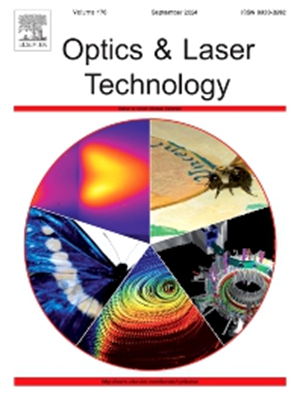A triple-channel optical fiber SPR sensor with high performance and low cost working below 1000 nm wavelength
IF 4.6
2区 物理与天体物理
Q1 OPTICS
引用次数: 0
Abstract
In this paper, we propose for the first time a triple-channel optical fiber surface plasmon resonance (SPR) refractive index (RI) sensor with an operating band below 1000 nm. The sensor consists of a U-shaped multimode fiber, a multimode-single mode-multimode (MSM) fiber and a core-offset fiber. To improve the performance of the triple-channel sensor and reduce crosstalk, we optimized each channel. For channel 3, the U-shaped fiber sputtering method was improved to solve the problems of over-wide resonance spectrum, disturbance dip at 500 nm and spectral saturation. For channel 1 and channel 2, the resonance wavelength was separated by sputtering gold film with different thickness. In addition, the length of sensing region was optimized and the core-offset structure was introduced to reduce channel crosstalk and improve sensor performance. Finally, the performance of the triple-channel sensor was tested. In the range of 1.3320 to 1.3615 RIU, the RI sensitivity of the three channels reached 965.3 nm/RIU, 2160.8 nm/RIU and 5556.9 nm/RIU respectively. Compared with other multi-channel optical fiber SPR sensors, the sensor has excellent spectral characteristics, and all three channels work in the band less than 1000 nm, so it has the advantages of high precision and low cost, and has broad application prospects in high-throughput biochemical detection platform.

求助全文
约1分钟内获得全文
求助全文
来源期刊
CiteScore
8.50
自引率
10.00%
发文量
1060
审稿时长
3.4 months
期刊介绍:
Optics & Laser Technology aims to provide a vehicle for the publication of a broad range of high quality research and review papers in those fields of scientific and engineering research appertaining to the development and application of the technology of optics and lasers. Papers describing original work in these areas are submitted to rigorous refereeing prior to acceptance for publication.
The scope of Optics & Laser Technology encompasses, but is not restricted to, the following areas:
•development in all types of lasers
•developments in optoelectronic devices and photonics
•developments in new photonics and optical concepts
•developments in conventional optics, optical instruments and components
•techniques of optical metrology, including interferometry and optical fibre sensors
•LIDAR and other non-contact optical measurement techniques, including optical methods in heat and fluid flow
•applications of lasers to materials processing, optical NDT display (including holography) and optical communication
•research and development in the field of laser safety including studies of hazards resulting from the applications of lasers (laser safety, hazards of laser fume)
•developments in optical computing and optical information processing
•developments in new optical materials
•developments in new optical characterization methods and techniques
•developments in quantum optics
•developments in light assisted micro and nanofabrication methods and techniques
•developments in nanophotonics and biophotonics
•developments in imaging processing and systems

 求助内容:
求助内容: 应助结果提醒方式:
应助结果提醒方式:


